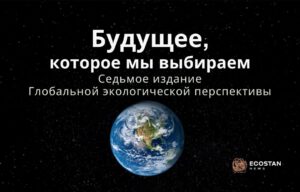Interview with Shattyk Tastemirova, Deputy Director of the Climate Policy Department at the Ministry of Ecology and Natural Resources of the Republic of Kazakhstan
Interviewer: Älimkhan Abulkhan — Chair of the youth organization Climate for Us, member of the regional youth network UNDP Generation Nexus for Climate, Peace, and Security
Editor: Aliya Wedelich, Ecostan News
Älimkhan Abulkhan: Kazakhstan has gained a reputation for its climate ambitions. Could you highlight three specific actions the country has taken to meet its climate commitments?
Shattyk Tastemirova: One of the most important milestones was the adoption, in 2023, of a long-term strategy to achieve carbon neutrality by 2060. This document sets a clear direction for our economy, making it evident that decarbonization is essential, that we have a target, and that concrete steps are needed to reach it.
Secondly, we updated key climate policy documents, including the Nationally Determined Contributions (NDCs). Alongside the long-term strategy, we revised our NDCs in 2023—this became known as the Updated or “second-generation” NDC. While the strategy sets the long-term vision, the NDC focuses on medium-term goals.
And thirdly, with the updated Environmental Code of Kazakhstan adopted in 2021, we expanded the chapter on greenhouse gas regulation and, for the first time, added a dedicated section on climate change adaptation.
Älimkhan Abulkhan: Given our continued reliance on fossil fuels and the need for major investment in low-carbon infrastructure, what do you see as the most critical challenges? And what measures are expected to be included in the upcoming NDC 3.0 over the next five years?
Shattyk Tastemirova: As we develop NDC 3.0, one of our key tasks is to define targets through 2035. Previously, our goal was to reduce emissions by 15% by 2030, compared to 1990 levels. Now we need to review that target and increase our level of ambition.
At the moment, we’re working on specifying and developing the mechanisms needed to reach these new goals. That’s why we’re actively collaborating with the Ministries of Energy and Industry—looking closely at how we can actually meet our targets.
For instance, as you may know, a new Nuclear Energy Agency has been established—this used to be a department within the Ministry of Energy. We’re now planning separate consultations with them. There may also be other potential pathways to achieving our objectives. What’s crucial is strong coordination across sectors and institutions, so we can identify what’s possible in each area. Article 6 of the Paris Agreement may also provide additional tools for reducing greenhouse gas emissions.
Älimkhan Abulkhan: What does the process of updating the NDC look like in practice?
Shattyk Tastemirova: Resources have already been mobilized, and a team of experts is working on emissions modeling. You can’t just say, “Let’s raise the target to 50%.” First, we need to thoroughly assess which sectors can reduce emissions, and by how much—both under a baseline scenario and in a more optimistic one. Only once that analysis is complete can we make sound, evidence-based decisions.
Älimkhan Abulkhan: If I’m not mistaken, NDC Partnership Kazakhstan has said that Kazakhstan is the first country in Central Asia to mobilize funding and expert support for the development of NDC 3.0.
How is coordination between ministries—such as Energy, Industry, and Agriculture—being organized to ensure NDC 3.0 targets are met?
Shattyk Tastemirova: We’ve formed an expert group that includes representatives of key government agencies as well as our partner organizations. You might remember: in early December 2024, we held a meeting with this group in an expanded format. These kinds of consultations are held regularly.
When there’s a need to discuss specific sectors—such as energy or agriculture—we hold dedicated meetings with the relevant ministries to explore their roles and potential contributions.
Once we have a draft of the NDC or the modeling results are ready, we plan to present them to the government. After all, this isn’t just a Ministry of Ecology document—it’s a commitment by the entire country.
Älimkhan Abulkhan: For young people and civil society, it’s important to know how the government plans to engage citizens, researchers, and youth in the preparation, discussion, implementation, and monitoring of NDC 3.0.
Shattyk Tastemirova: As I mentioned, resources have already been mobilized, and several organizations working with different groups and focus areas are now involved in the process.
For example, UNICEF is actively engaging with youth. With their support, we’re working on mechanisms to ensure young people can participate meaningfully in decision-making and that their voices are heard—both in broader climate policy and in the NDC process specifically.
The Ministry of Ecology and Natural Resources is also considering the creation of a Youth Environmental Council. This initiative is currently being developed by the Department of Environmental Policy.
In addition, we strive to include youth representatives in Kazakhstan’s delegations to the UN Climate Conferences (COP). We want to ensure that climate summits include not only government officials but also young people, academics, and civil society—so Kazakhstan is represented at all levels.
Älimkhan Abulkhan: The idea of a Youth Council is really interesting. Will it focus solely on climate issues, or on the broader environmental agenda?
Shattyk Tastemirova: It will focus on the broader environmental agenda. Initially, we considered a climate-only council, but eventually concluded it made more sense to include the entire environmental scope, including climate, which reflects how the ministry itself is structured. The initiative to create the council came from the Minister, and our team is currently working on the details and the approval process.
One more important point: in 2026, Kazakhstan will host a Regional Environmental Summit, and we want it to feature a dedicated youth track—with its own sessions and space for youth engagement.
We’d also like to invite the Presidency Youth Climate Champions. For example, at COP29 in Azerbaijan, Leyla Hasanova served in that role; at COP28 in Dubai, it was Shamma Al Mazrui. I believe similar collaborations could be possible for us as well.
Although the summit will be regional, we want the youth sessions to have broad, international participation. The more diverse the group, the stronger the platform for young people from our region to share their ideas and initiatives.
Älimkhan Abulkhan: Thank you so much for the engaging conversation and your openness!
Prepared specially for the UNDP Generation Nexus for Climate, Peace, and Security network and Ecostan News




